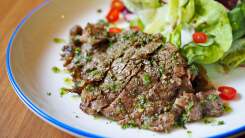Do You Really Need to Chill Your Pie Dough?
Everyone knows that a chef’s kiss-worthy pie crust requires cold butter, which is why most recipes recommend chilling the dough twice: Once after mixing, and again after assembling the pie. The downside is that rolling out cold dough sucks, so you’ll have to wait for it to warm up first (or smack it around a little), adding at least another hour to your baking schedule.
That is, unless you opt out and skip the initial chill altogether. Don’t get me wrong, there are definitely arguments for chilling your dough before rolling it out—especially if you’re making it ahead of time—but that doesn’t mean you have to. You can go directly from mixing, to rolling, to assembly, and nothing bad will happen. In fact, your pie will probably turn out better.
Less chilling means less waiting
The first and most obvious plus to skipping that first chilling step is that it will basically halve your prep time. Fridge-cold dough might take an hour to warm up at 75ºF, but if you keep your thermostat anywhere below 70ºF, that hour can easily stretch into two or even three—and that’s not counting the time it took to chill it in the first place. Considering pie-making is a long, involved process, this is a pretty big deal—especially on a big cooking day like Thanksgiving.

Warmer dough is easier to work with
Even slightly-too-cold dough is prone to cracking, crumbling, and generally not behaving the way you want it to. (I’ve been making pies for over a decade and half my attempts still end up looking like the Millennium Falcon.) But room-temperature dough is malleable and soft. Not only is it easier to roll out, it’s also less likely to crack—and if it does, it actually sticks to itself, so you can patch things up with no trouble at all.
That last feature is more important than it sounds. Dough that sticks to itself can be molded however you like, and once it’s been chilled to set the shape in place, it’ll stay that way. Whether you’re doing a basic crimped edge or an intricate herringbone lattice adorned with cutouts, starting with soft, pliable dough gives your decorations the best possible shot at surviving the oven.
How to do it
Applying this technique is as easy as it sounds: Make your favorite pie crust recipe, and skip the initial chilling step. You’ll need to work quickly when rolling out the dough, but unless your kitchen is warmer than about 75ºF, there’s no reason to stress about it too much. Your hands are the main heat source in this scenario, and they’re unlikely to warm your rolling pin and counters up to 90ºF, which is the temperature where butter usually starts to melt.
This eliminates some downtime, so you may want to adjust your filling prep. Single-crust custard pies work best when you add hot custard to a hot, freshly blind-baked crust, so keep that in mind when planning your timing. For double-crust pies, have the filling ready to go before you start mixing your dough. As long as you thoroughly chill the assembled pie (or crust-lined plate) before baking, the butter will be plenty cold when it hits the hot oven.
RECOMMENDED NEWS

Your Broccoli Stems Can Make a Tasty Tart
2025-10-16

How to Give Your Wing Sauce Deeper Flavor With Browned Butter
2025-10-15

Khai Jiao Is the Best Way to Use Leftover Mung Bean Sprouts
2025-10-19

The Difference Between Bay Scallops and Sea Scallops, and How to Cook Both
2025-10-16

9 Foods You Don't Need to (or Shouldn't) Refrigerate
2025-10-15

A cut of grilled beef plated next to a salad
2025-10-16
Comments on "Do You Really Need to Chill Your Pie Dough?" :